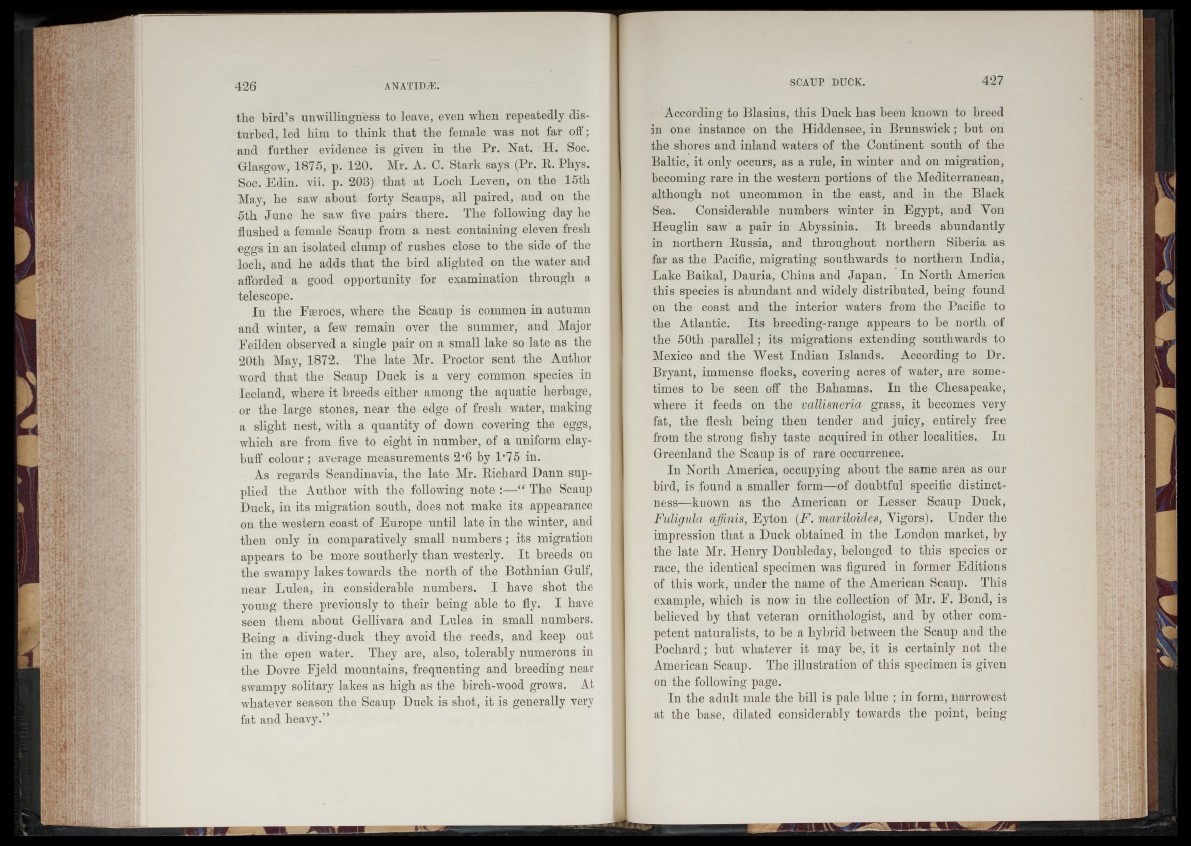
tlie bird’s unwillingness to leave, even when repeatedly disturbed,
led him to think that the female was not far oft ;
and further evidence is given in the Pr. Nat. H. Soc.
Glasgow, 1875, p. 120. Mr. A. C. Stark says (Pr. K. Phys.
Soc. Edin. vii. p. 208) that at Loch Leven, on the 15th
May, he saw about forty Scaups, all paired, and on the
5th June he saw five pairs there. The following day he
flushed a female Scaup from a nest containing eleven fresh
eggs in an isolated clump of rushes close to the side of the
loch, and he adds that the bird alighted on the water and
afforded a good opportunity for examination through a
telescope.
In the Faroes, where the Scaup is common in autumn
and winter, a few remain over the summer, and Major
Feilden observed a single pair on a small lake so late as the
20th May, 1872. The late Mr. Proctor sent the Author
word that the Scaup Duck is a very common species in
Iceland, wdiere it breeds either among the aquatic herbage,
or the large stones, near the edge of fresh water, making
a slight nest, with a quantity of down covering the eggs,
which are from five to eight in number, of a uniform clay-
buff colour; average measurements 2'6 by P75 in.
As regards Scandinavia, the late Mr. Bichard Dann supplied
the Author with the following note :—“ The Scaup
Duck, in its migration south, does not make its appearance
on the western coast of Europe until late in the winter, and
then only in comparatively small numbers ; its migration
appears to be more southerly than westerly. It breeds on
the swampy lakes towards the north of the Bothnian Gulf,
near Lulea, in considerable numbers. I have shot the
young there previously to their being able to fly. I have
seen them about Gellivara and Lulea in small numbers.
Being a diving-duck they avoid the reeds, and keep out
in the open water. They are, also, tolerably numerous in
the Dovre Fjeld mountains, frequenting and breeding near
swampy solitary lakes as high as the birch-wood grows. At
whatever season the Scaup Duck is shot, it is generally very
fat and heavy.”
According to Blasius, this Duck has been known to breed
in one instance on the Hiddensee, in Brunswick; but on
the shores and inland waters of the Continent south of the
Baltic, it only occurs, as a rule, in winter and on migration,
becoming rare in the western portions of the Mediterranean,
although not uncommon in the east, and in the Black
Sea. Considerable numbers winter in Egypt, and You
Heuglin saw a pair in Abyssinia. It breeds abundantly
in northern Kussia, and throughout northern Siberia as
far as the Pacific, migrating southwards to northern India,
Lake Baikal, Dauria, China and Japan. In North America
this species is abundant and widely distributed, being found
on the coast and the interior waters from the Pacific to
the Atlantic. Its breeding-range appears to be north of
the 50tli parallel; its migrations extending southwards to
Mexico and the West Indian Islands. According to Dr.
Bryant, immense flocks, covering acres of water, are sometimes
to be seen off the Bahamas. In the Chesapeake,
where it feeds on the vallisneria grass, it becomes very
fat, the flesh being then tender and juicy, entirely free
from the strong fishy taste acquired in other localities. In
Greenland the Scaup is of rare occurrence.
In North America, occupying about the same area as our
bird, is found a smaller form—of doubtful specific distinctness^—
known as the American or Lesser Scaup Duck,
Fuligula affinis, Eyton (F . mariloides, Yigors). Under the
impression that a Duck obtained in the London market, by
the late Mr. Henry Doubleday, belonged to this species or
race, the identical specimen was figured in former Editions
of this work, under the name of the American Scaup. This
example, which is now in the collection of Mr. F. Bond, is
believed by that veteran ornithologist, and by other competent
naturalists, to be a hybrid between the Scaup and the
Pochard; but wdratever it may be, it is certainly not the
American Scaup. The illustration of this specimen is given
on the following page.
In the adult male the bill is pale blue ; in form, narrowest
at the base, dilated considerably towards the point, being